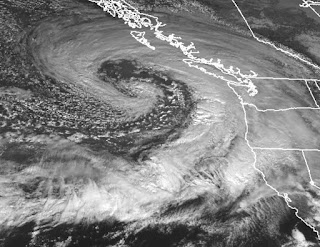Tornadoes are relatively rare in Washington State, generally with 2-3 weak ones per year. But today, something very rare occurred a midwinter tornado of moderate strength, perhaps as high as EF-2 on the Enhanced Fujita scale.
The action happened in Port Orchard, Washington, near the Walmart Supercenter (see map), shortly before 2 PM.
There was substantial damage with roofs lost and severe structural damage to 6-10 homes, and many trees downed, including entire wooded areas.
There was some great video of the tornado, showing debris ejected hundreds or thousands of feet in the air (see picture taken by Mathew Hargis)
The first thing a meteorologist does in this situation is to look at the radar, and sure enough there was an area of high reflectivity (heavy precipitation) over Port Orchard at the time of the tornado (see radar image below for 1:51 PM). Such an area would be associated with a strong thunderstorm or convective cell. But you will note there were others at other locations that were equally as intense.
The next thing is to check is strength of the convective cell, as expressed by its height or "top" (see below). Just 15,000 to 20,000 ft--pretty wimpy. Folks in Oklahoma would laugh.
So why a tornado? Well, the next thing a meteorologist would look at is the Doppler velocities, to determine whether there was local rotation--a mesocyclone. Such rotation can be spun up into a tornado. I checked the Doppler radar imagery: there was a weak hint of rotation for the lowest beam elevation angle (.5 degrees). This is illustrated by the adjacent couplet of colors (yellow-blue) in the lowest beam level at 2132 UTC (1:32 PM), 2146 UTC (1:46 PM) and 2151 UTC (1:51 PM)-the light yellow being roughly 5 knots towards the radar, while dark blue being around 40 knots. That difference reflect a small scale rotation.
And there was no hint of a "hooked echo" in the reflectivity (intensity). Bottom line: this was a very weakly rotating, non-supercell thunderstorm.
And a forecast of the amount of "juice" available for thunderstorms/convection at the time of the tornado (something called CAPE, Convective Available Potential Energy) is nothing you would write home to your mother about (unless you were a meteorologist, of course--I write my mother all the time about weather matters). CAPE values were into the low hundreds-- fairly high for our region, but nothing impressive.
OKAY.... most of our tornadoes around here are not from supercells anyway, and tornadoes usually occur when a modest thunderstorm interactions with an environment with some horizontal shear (change of wind speed and direction with distance). Such shear represents inherent rotation which can be "spun up" as air is ingested into a thunderstorm.
Was there much shear that day around Port Orchard around 2 PM? A short-term, high-resolution forecast of wind speed and direction for 2 PM suggested a modest amount of velocity shear around the Port Orchard region, with weaker winds in the immediate lee (east) of the Olympics in contrast to stronger southwesterly winds coming around its southern flank. So weak shear did exist in the lee of the Olympics.
So where are we then?
The air moving into western Washington was modestly unstable and as a result a number of convective/thunderstorm showers were moving in. Nothing exceptional. One of the thunderstorm cells moved into the lee of the Olympics, where some horizontal wind shear existed. Such shear implies inherent rotation (think of placing a very large pinwheel in such an environment--it would spin). The modest thunderstorm ingested that air and spun up the rotation in its strong updraft (not unlike a skater can speed up a rotation by drawing her arm toward her/his body). This created the tornado.
This is not the first tornado that formed in the wind shear zone in the lee of the Olympics. Several others have occurred during the past decades, such as one near Poulsbo in April 1991. But a tornado this strong during the mid-cool season is very unusual.
Most tornadoes in WA state are wimpy EF-0s. (See scale below) But this one appears stronger, EF-1 at least, and perhaps an EF-2.
No one should criticize my colleagues at the National Weather Service for not forecasting this event earlier in the day. It is possible that a warning might have been able to be put out a 10-15 minutes before---although is not Oklahoma where they have tornado warning infrastructure in place like sirens. Interestingly, an amateur group (WA storm chasers), noticed the rotation and tweeted out a warning at 1:37 AM (see below):
I wonder whether the National Weather Service's automated rotation detection software picked up on the rotating storm.
Such weak tornadoes are relatively rare, since everything had to happen perfectly, with the shear and a strong storm coming together at the right time and place.
 Finally, the fog was evident in the 10:45 AM image from the new GOES-17 weather satellite (see below). Fog extended east, north and south along the river valleys, but ended at the Sound. A wonderful morning to hike up to the top of Cougar or Tiger Mountains and look down on the clouds below. Great visibility aloft. And the fog won't last...much will burn off during the next few hours.
Finally, the fog was evident in the 10:45 AM image from the new GOES-17 weather satellite (see below). Fog extended east, north and south along the river valleys, but ended at the Sound. A wonderful morning to hike up to the top of Cougar or Tiger Mountains and look down on the clouds below. Great visibility aloft. And the fog won't last...much will burn off during the next few hours.




























































